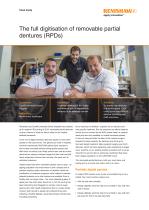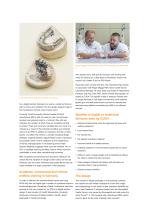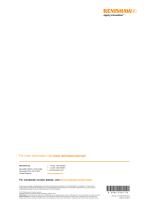
Catalog excerpts

Case study Customer: Cardiff University Dental Hospital Industry: Medical and healthcare Challenge: To design dentures in the digital environment and to manufacture dentures in an effective manner. Solution: To directly manufacture in a dental grade, CoCr using Renishaw's AM250 additive manufacturing (AM) machines. Renishaw and Cardiff University Dental Hospital have teamed up to research 3D printing of CoCr removable partial dentures to give a flavour of what the future holds for the humble skeletal framework. In the era of digital dentistry, dentures appear to have been placed on the back burner. The glamorous world of implants and their intertwined CAD/CAM options have resulted in the humble removable denture being gently passed over. Well that’s not strictly true. Wrap around bars and all-on-four dentures are seeing continued usage but their hard and soft tissue supported cousins have not seen the same sort of extensive makeover. Implant sales have seen consistent growth year-on-year - an ageing population has meant there is still a steady flow of patients requiring major restoration of dentition whilst the proliferation of makeover programs have helped to educate potential patients as to what options are available. Even a healthy diet no longer helps - the once detoxifying glass of apple juice has since been found out. A 150 ml serving has been claimed by the Telegraph to contain 4 tsp of sugar. Ignoring the other health implications this is a major dental concern and has led to people who believed they were following a healthy lifestyle, requiring premature dental care including extractions. So to treat loss of dentition, implants are an obvious and now popular treatment. But not everyone can afford implants (which are not covered by the NHS unless there’s a medical need) and are only available on limited insurance policies. In fact not everyone likes the idea of the invasive surgery required to place implants. So dentures are still a go-to, tried and tested treatment. Many patients happily wear CoCr dentures, which will need replacing when anatomical changes occur overtime, so an existing market is present and is just as important to service. But as previously mentioned they have been largely passed by on the CAD/CAM circuit. The removable partial denture is still very much alive and kicking and is a crucial tool where cost is an issue. Partially digital partials In today’s RPD market one’s choice of manufacturing is very limited. Your most common options are: • Wax up and cast manually. • Design digitally, send the data to be printed in wax and then cast in-house. • Design digitally, send the data to be printed in wax and then pay extra for this to be cast externally.
Open the catalog to page 1
Roger Maggs CUDH and Paul Clark CUDH assessing the latest case fit. He’s always had a soft spot for dentures and working with metal 3D printing on a daily basis at Renishaw, means this couldn’t be a better fit for his PhD thesis. A 3D printed RPD, polished and ready for build up. So a digital denture framework is nearly a reality but there is still no end-to-end workflow from the design stage through to the manufacture without major manual input. Currently Cardiff University Dental Hospital (CUDH) manufacture 380 to 400 chromes per year and although remakes are generally kept to a minimum...
Open the catalog to page 2
Once the master model was scanned it was imported directly into the Freeform software. From here the operator can start to identify the insertion axis and block out undercuts. The undercuts can be varied to allow for tighter or looser retention. Also at this time, clearance from the gingiva can be dialled in to accommodate acrylic thickness. Following this the design process can really start in earnest. A full suite of indirect and direct retainers, major connectors and acrylic retention features can be designed into the denture. Using the Haptic arm can be a little alien at first but...
Open the catalog to page 3
apply innovation™ Renishaw pic New Mills, Wotton-under-Edge Gloucestershire, GL12 8JR United Kingdom For worldwide contact details, visit www.renishaw.com/contact RENISHAW HAS MADE CONSIDERABLE EFFORTS TO ENSURE THE CONTENT OF THIS DOCUMENT IS CORRECT AT THE DATE OF PUBLICATION BUT MAKES NO WARRANTIES OR REPRESENTATIONS REGARDING THE CONTENT. RENISHAW EXCLUDES LIABILITY, HOWSOEVER ARISING, FOR ANY INACCURACIES IN THIS DOCUMENT. © 2016 Renishaw plc. All rights reserved. Renishaw reserves the right to change specifications without notice. RENISHAW and the probe symbol used in the RENISHAW...
Open the catalog to page 4All Renishaw catalogs and technical brochures
-
LaserImplant™
1 Pages
-
inVia™ confocal Raman microscope
28 Pages
-
WiRE™ software
8 Pages
-
M6 CMM clamping kit
2 Pages
-
Renishaw CMM fixtures
36 Pages
-
Mission to Nepal
4 Pages
-
3D modelling and printing
4 Pages
-
LaserAbutments™
4 Pages
-
DS10 system specifications
2 Pages
-
neuromate® stereotactic robot
17 Pages
-
Brochure neuromate
16 Pages
-
Brochure : Delivering precision
16 Pages
-
Neuroguide leaflet
2 Pages






















